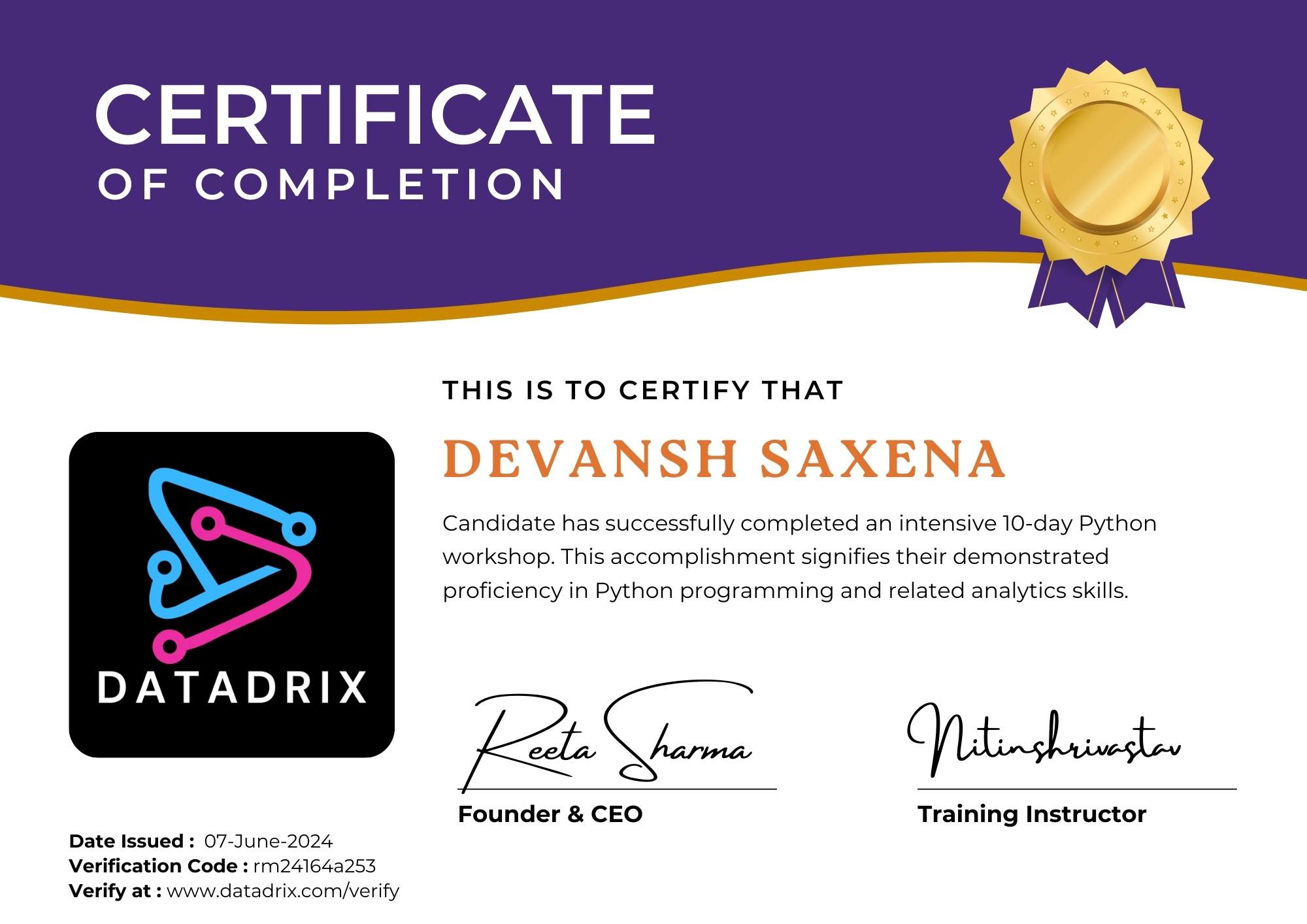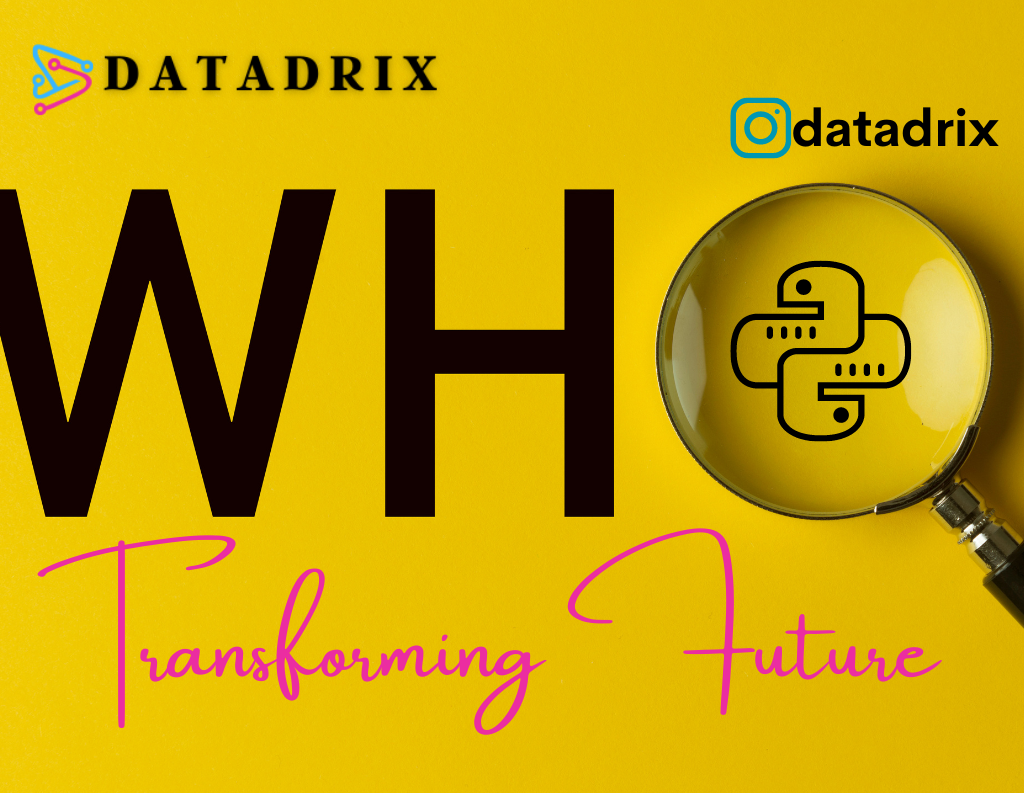
DATADRIX : Python Programming
Unlocking the Power of Programming with Python
Discover the boundless potential of Best Python Training in delhi through our comprehensive course. Python, known for its simplicity and versatility, is a programming language that opens doors to endless possibilities. In our program, you’ll embark on a journey to grasp the fundamental concepts of Python, equipping yourself with a solid foundation. With hands-on projects and real-world applications, you’ll develop practical skills that empower you to create solutions for a wide range of challenges. Whether you’re a novice or experienced programmer, our course is designed to accommodate learners at all levels. Python’s elegant syntax and vast library ecosystem make it a powerful tool for web development, data analysis, artificial intelligence, and more.
Python Programming
Building the Future of Technology From Scratch
Our Best Python Training Course in Delhi is designed to provide participants with a comprehensive understanding of Python programming language and its applications. Whether you are a beginner or have some programming experience, this course will equip you with the knowledge and skills needed to develop Python-based solutions. By the end of the Python training course, you will have a solid foundation in Python programming, allowing you to develop scripts, build applications, and explore specialized domains like web development, data analysis, and more. Join us on this learning journey and unlock the full potential of Python programming for your career advancement.
Python, a programming language renowned for its simplicity and power, serves as an ideal launchpad for aspiring developers and a versatile tool for seasoned professionals in the ever-evolving landscape of technology. At DATADRIX, Best training in institute in delhi for python programming we offer a nurturing environment for both freshers and experienced students to embark on an exciting journey with Python.
Embark on your Python journey with the best Python training in Delhi, offered in our first module. Delve into the history of Python, installation procedures, configurations, and foundational Python programming basics. Our training adheres to international industry standards, covering the latest trends and techniques. Datadrix provides an unparalleled IT infrastructure and a conducive learning environment. Enroll in our courses to become market-ready and excel in Python coding. Datadrix, your gateway to the best Python training in Delhi, welcomes you to a transformative learning experience.
Datadrix stands out as the unequivocal leader, securing its position as the best Python Training Institute in Delhi. With over 10 years of industry experience and expertise in IT and IoT, Datadrix is at the forefront of the latest industry trends. What sets Datadrix apart is the practical approach to learning, facilitated by industry professionals and veterans with extensive experience as trainers. Our flexible and adaptive curriculum ensures alignment with the ever-changing needs of the industry, making Datadrix the ultimate destination for the best Python training in Delhi.
For beginners, Python’s intuitive syntax and rich ecosystem make it a perfect starting point. Our tailored courses cover the fundamentals, from variables and data types to control structures, functions, and object-oriented programming. As freshers dive into hands-on projects, they gain a solid foundation, equipping them to explore the worlds of web development, data analysis, and artificial intelligence.
For experienced programmers, Python acts as a potent addition to their skill set. It empowers them to streamline tasks, automate processes, and tackle complex challenges with ease. Our advanced Python courses delve into topics like web frameworks, data science libraries, and machine learning, enabling professionals to stay competitive in their fields.
Python isn’t just a language; it’s a gateway to innovation. With its immense community support and cross-industry applicability, it’s a valuable asset for any developer. Whether you’re setting foot into the tech world for the first time or enhancing your expertise, our institute is committed to helping you harness Python’s potential and write your success story in the realm of programming. Join us, and let’s explore the boundless opportunities that Python has to offer, whether you’re a fresher seeking to establish a strong foundation or an experienced pro aiming to stay at the forefront of technological advancements.
In-Demand Skill: Python is one of the most sought-after programming languages in today’s tech job market. Learning Python opens doors to a wide range of career opportunities in software development, data science, artificial intelligence, and more.
Beginner-Friendly: Python’s simple and readable syntax makes it an ideal choice for newcomers to programming. It’s a great starting point for those with little to no coding experience.
Versatility: Python’s versatility is a key strength. It’s used for web development, scientific computing, automation, data analysis, and machine learning, among other fields.
Structured Learning: Our training institute offers structured Python courses designed to take students from the basics to advanced concepts. Whether you’re a beginner or an experienced programmer, we have tailored courses for your skill level.
Hands-On Practice: Learning Python is not just about theory; it’s about hands-on coding. Our courses include practical exercises, real-world projects, and coding challenges to reinforce your skills.
Experienced Instructors: Our experienced instructors are well-versed in Python and bring real-world expertise to the classroom. They guide you through the learning process and provide valuable insights.
Career Advancement: For experienced professionals, Python training is an excellent way to enhance your skill set and stay relevant in a rapidly evolving tech landscape. It can lead to new career opportunities or advancements in your current job.
Job Placement Support: Our training institute offers job placement support to help students, both freshers and experienced, find employment in their desired fields. We connect you with industry partners and provide job placement assistance.
Community and Networking: Python is supported by a robust and active community. Our training programs often provide opportunities for networking and collaboration with fellow learners and professionals in the field.
Certification: Upon completing our Python training, students receive certification, which is a valuable addition to your resume, showcasing your expertise to potential employers.
Continuous Learning: Python is an ever-evolving language. Our training institute emphasizes continuous learning, ensuring that you stay updated with the latest trends and advancements in the Python ecosystem.
Embarking on a Best Python training in dilshad garden at DATADRIX is an investment in your future, whether you’re just starting your career or looking to further develop your skills. We welcome both fresher and experienced students to join us and explore the exciting world of Python programming.

Course Curriculam :
A syllabus is a meticulously crafted document that serves as a comprehensive roadmap for the training program. It plays a pivotal role in guiding candidate along their learning journey, offering a structured framework for acquiring knowledge and honing skills.
A well-designed syllabus offers a bird’s-eye view of the course’s content, complete with a meticulous breakdown of modules or units, well-crafted lesson plans, and a timeline for completion. It doesn’t merely outline what candidate will learn but also lays out the precise learning outcomes and objectives that they’re expected to master by the course’s conclusion.
Embedded within the syllabus are detailed descriptions of each topic, accompanied by a treasure trove of learning resources, suggested readings, and insights into the methods by which knowledge will be assessed. It’s not just a map, it’s a compass guiding candidate through a labyrinth of assignments, projects, exams, and a transparent grading system, making their educational journey as informed and rewarding as possible.
Module 1
Module 2
Module 3
Module 4
An Awesome Community
Our students, instructors and mentors come from different colleges, companies, and walks of life.
Meet our team and students

Joining DATADRIX means you’ll create an amazing network, make new connections,
and leverage diverse opportunities.

“Validate Your Expertise and Propel Your Career”
- Certification: A testament to your skills and knowledge, certifications demonstrate your proficiency in specific areas of expertise, giving you a competitive edge in the job market.
- Expand Opportunities: Certifications to unlock new career opportunities, gain credibility with employers, and open doors to higher-level positions.
- Continuous Growth: Certifications not only validate your current skills but also encourage continuous learning and professional development, allowing you to stay updated with the latest industry trends and advancements.
Frequently Asked Questions

Who can make career transition into Python ?
Graduate or working professional with a passion for technology & desire to broaden their skillset can transition into a Python career.

What are the key features of Python ?
Offering clear and concise syntax that emphasizes readability. Additionally, its versatile because its library & community support.

Best Python Training in Delhi – DATADRIX
Python training at the leading institute in Delhi. Hands-on projects & 100% job assistance ensure successful Python journey.

Duration and scope of python language
Friendly syntax, allows quick proficiency, making it an ideal to learn in a short duration. Vast scope in the tech industry.
